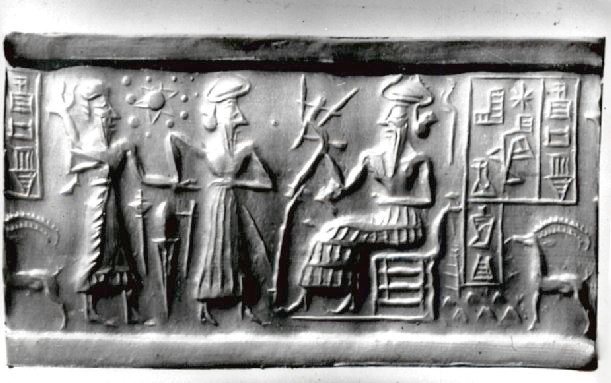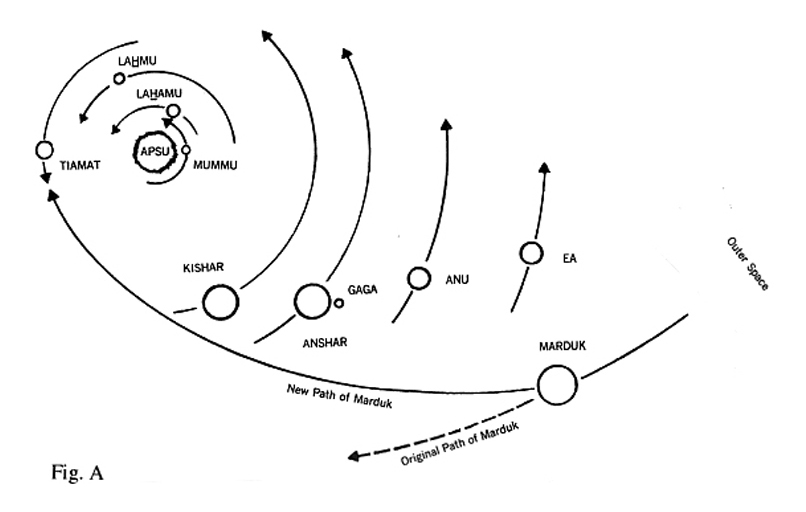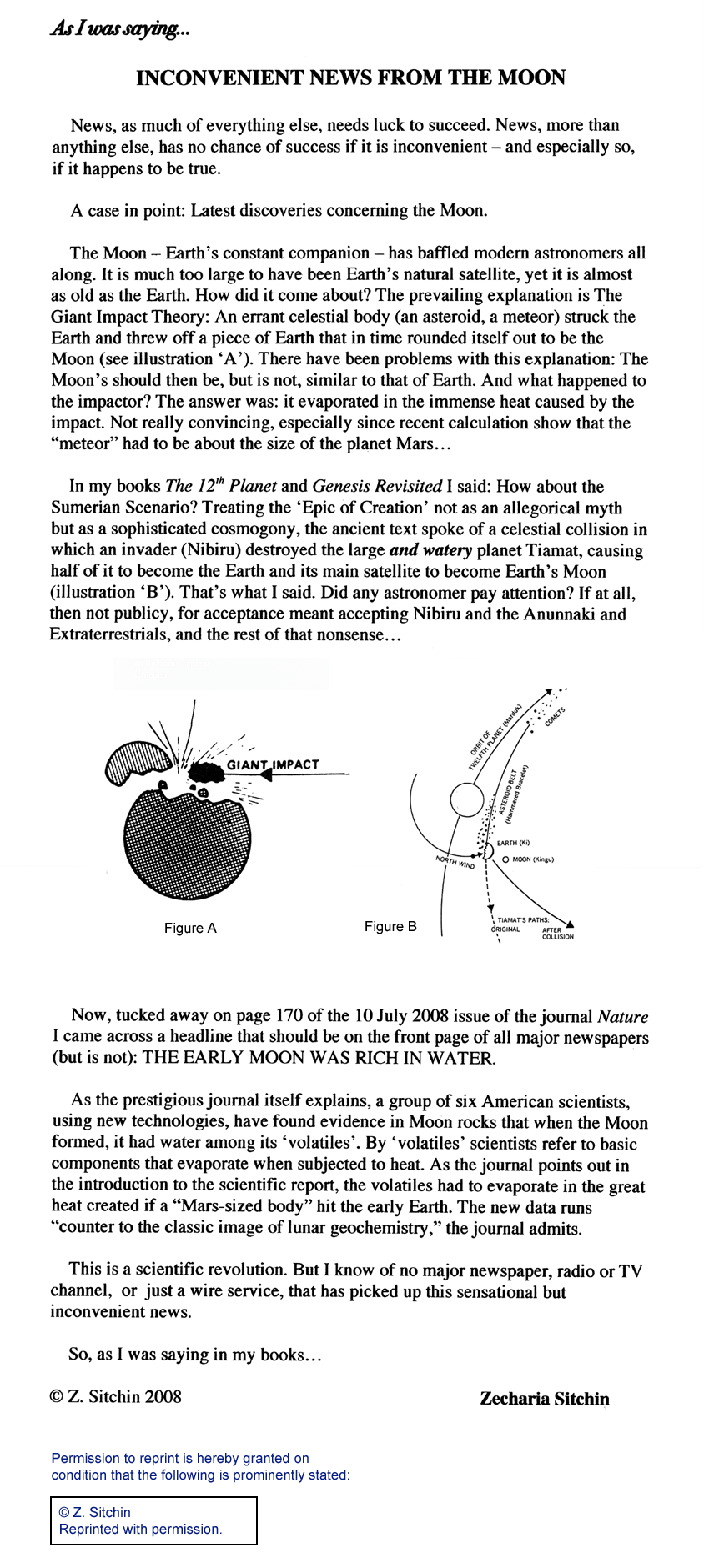Is it Nibiru?
This cylinder seal, VA-243 in the Berlin Near Eastern Museum, shows the sun in the center (!), surrounded by eleven orbiting bodies that include the Moon, Pluto and the yet to be recognized Planet X -- Nibiru. 
|
|
Ancient Babylonian astronomers calculated Jupiter's position from the area under a time-velocity graphThere is more exciting scientific news this week that corroborates Sitchin writings. Last week we heard new evidence of the existance in our solar system of another large planet, which might be Nibiru. This week Mathieu Ossendrijver published an article in Science magazine about a cuneiform tablet detailing the position of Jupiter based on geometrical calculations by the Babylonians in 350-50 BCE. Europeans were able to do this in the 1400's. Mathieu Ossendrijver Science 29 Jan 2016: Vol. 351, Issue 6272, pp. 482-484 DOI: 10.1126/science.aad808 Abstract: "The idea of computing a body's displacement as an area in time-velocity space is usually traced back to 14th-century Europe. I show that in four ancient Babylonian cuneiform tablets, Jupiter's displacement along the ecliptic is computed as the area of a trapezoidal figure obtained by drawing its daily displacement against time.This interpretation is prompted by a newly discovered tablet on which the same computation is presented in an equivalent arithmetical formulation.The tablets date from 350 to 50 BCE.The trapezoid procedures offer the first evidence for the use of geometrical methods in Babylonian mathematical astronomy, which was thus far viewed as operating exclusively with arithmetical concepts."For more information, see the full article in Science: http://science.sciencemag.org/content/sci/351/6272/482.full.pdf J.Sitchin - January 29, 2016 |
|
Regarding the January 19, 2016 publication of an article in The Astronomical Journal about evidence for another large planet in our solar system in the Kuiper Belt beyond Pluto, I wrote on January 20: With an elliptical orbit of 10,000 or 20,000 of our years, this planet may not be Nibiru, which has an orbit of about 3600 of our years. However, this prediction of a likely additional planet in our solar system is exciting news. Perhaps the search will lead us to either finding Nibiru, or perhaps we'll find that something has changed and impacted Nibiru's orbit since the last time it orbited Earth. I have my doubts, but since I'm not an astronomer, I'll keep an open mind. I don't think this is Nibiru.J.Sitchin - January 20, 2016 After speaking with my father, Amnon Sitchin, brother to Zecharia Sitchin, PhD in Aeronautical and Mechanical Engineering, and also the person who calculated the orbit of Nibiru for my uncle Zecharia, I found an interesting piece of news based on some additonal calculations he did this week: If Nibiru's orbit of 3600 years was circular rather than elliptical, it would have an orbit of about 10,000 years.Yes, you heard that right. I don't know whether the CalTech astronomers based their estimated orbital period on a circular or elliptical orbit. However, this tidbit means that I should not dismiss this planet as being Nibiru based on this estimated orbital time frame. I obviously need to learn more about planetary motion and astronomy to make any conclusions myself. I'm hoping that we can learn more and either find that this is Nibiru or that the search for this new planet helps us find Nibiru too. J.Sitchin - January 27, 2016 |
|
Konstantin Batygin and Michael E. Brown Published 2016 January 20 © 2016. The American Astronomical Society. All rights reserved. The Astronomical Journal, Volume 151, Number 2 The following is the abstract of the article in The Astrononomical Journal on the subject of the new findings regarding another planet in our solar system. "Recent analyses have shown that distant orbits within the scattered disk population of the Kuiper Belt exhibit an unexpected clustering in their respective arguments of perihelion. While several hypotheses have been put forward to explain this alignment, to date, a theoretical model that can successfully account for the observations remains elusive. In this work we show that the orbits of distant Kuiper Belt objects (KBOs) cluster not only in argument of perihelion, but also in physical space. We demonstrate that the perihelion positions and orbital planes of the objects are tightly confined and that such a clustering has only a probability of 0.007% to be due to chance, thus requiring a dynamical origin. We find that the observed orbital alignment can be maintained by a distant eccentric planet with mass >~ 10m whose orbit lies in approximately the same plane as those of the distant KBOs, but whose perihelion is 180° away from the perihelia of the minor bodies. In addition to accounting for the observed orbital alignment, the existence of such a planet naturally explains the presence of high-perihelion Sedna-like objects, as well as the known collection of high semimajor axis objects with inclinations between 60° and 150° whose origin was previously unclear. Continued analysis of both distant and highly inclined outer solar system objects provides the opportunity for testing our hypothesis as well as further constraining the orbital elements and mass of the distant planet."J.Sitchin - January 21, 2016 |
|
The New York Times, The BBC, The New Yorker, National Public Radio and other highly respected news sources reported today (January 20, 2016) that there is strong evidence for a ninth planet in our solar system. (I'm not quite willing to demote Pluto, so I'm saying tenth planet). In the New York Times, reporter Kenneth Chang says: "Two astronomers reported on Wednesday that they had compelling signs of something bigger and farther away - something that would definitely satisfy the current definition of a planet, where Pluto falls short. The scientists were working on calculations to explain the behavior of several Kuiper Belt objects. As a result, they were pretty sure there was a large object that exhibited a gravitational pull on those objects to explain their movement. When they included a large planet orbiting in the reverse direction from those objects into their simulation, the calculations worked and the objects were where the calculations predicted they would be. "Another strange result in the simulations: A few Kuiper belt objects were knocked into orbits perpendicular to the plane of planetary orbits. Dr. Brown remembered that five objects had been found in perpendicular orbits.J.Sitchin - January 20, 2016 New scientific discoveries continue to corroborate findings first suggested in Zecharia Sitchin's books. Homo sapiens: The successful deciphering of a female Neanderthal genome was reported in the journal Science on February 13, 2009. The project, undertaken by scientists at the Max Planck Institute in Leipzig, Germany, aimed to verify when that failed species of humans and Homo sapiens (= Modern Man) branched off, and whether the two bad ever interbred. The New York Times pointed out that the new findings "document two important sets of genetic changes - those that occurred between 5.7 million years ago, when the human line split from the line leading to chimpanzees, and 300,000 years ago when Neanderthals and the ancestors of modern humans parted ways." In The 12th Planet (1976), describing the Anunnaki's genetic engineering to fashion The Adam, Zecharia wrote: "Man is the product of evolution; but modern Man, Homo sapiens, is the product of the 'gods'. For, some time circa 300,000 years ago, the Nefilim took ape-man (Homo erectus) and implanted on him their own image and likeness." In The Earth Chronicles Time Chart (The Wars of Gods and Men, 1985) Zecharia wrote: 300,000 years ago: The Anunnaki toiling in the gold mines mutiny. Enki and Ninhursag create Primitive Workers through genetic manipulation... Homo sapiens begins to multiply." The Deluge: In The 12th Planet and Divine Encounters Zecharia suggested that the biblical Flood was a giant tidal wave caused by the slippage of the ice sheet off Antarctica, causing the abrupt end of the last Ice Age circa 13,000 years ago. Two recent studies corroborate both aspects of Zecharia's take on the subject: A study of ancient temperatures in the journal Nature of 26 February 2009 concludes that while warming at the end of the last Ice Age was relatively gradual in Greenland (north Atlantic), it was "rapid and abrupt" in Antarctica (south Atlantic), about 13,000 years ago. A study of ancient sea levels published in Science of 6 February 2009 concludes that (a) Antarctica's ice sheet collapsed abruptly and (b) that due to the topography of the continent and its surrounding sea beds, the tidal wave was at least three times higher than hitherto calculated, reaching its maximal impact some 2,000 miles away. A diagram accompanying the article shows the area of maximal tidal impact in the Persian Gulf, the Mediterranean Sea and northward therefrom - the very Lands of the Bible and Mount Ararat. ... Sitchin's Audacious Assertion That planets might orbit stars other than our Sun has been theoretically held possible, though doubtful, for some time; but it was only in 1988 that Canadian astronomers attained the first-ever confirmed discovery of one such planet - a confirmation that was achieved only in 2003. Yet it was years earlier, when The 12th Planet was published in 1976, that Zecharia Sitchin made the audacious assertion that not only do extrasolar planets exist, but that other planetary systems can come into being, exist, and can also meet a violent end. He reached that conclusion by treating the Mesopotamian Epic of Creation Enuma elish not as an allegorical myth of Good v. Evil (as other scholars do) but as a sophisticated cosmogony scientifically relating our Solar System's history. Thus treated, he wrote, the text tells that our Solar System, when still in its early phase, was invaded by a foreign planet thrust out of its own solar system; eventually passing near our Solar System, it was pulled in by gravitational forces, ending up (after a collision) as a member of our Solar System. The Summaerians named it Nibiru; the Babylonians renamed it Marduk in honor of their national god. That scenario, which explains a host of astronomical enigmas, was illustrated in the book by several diagrams, including Fig. A:  Amazingly, several highly intriguing aspects of NASA's discoveries mesh with ancient knowledge (what many deem myths or legends). The second team's newly discovered world orbits the bright southern star Fomalhaut, whose name (coming from Arabic) means 'The Fish's Mouth'. Very bright, it is the lead star in the constellation Piscis Australis - "The Southern Fish." Situated below (i.e. south of) the larger constellation Aquarius ("the Water Bearer"), it has been traditionally depicted as a fish nourished by water pouring down from the jar of Aquarius, and linking it to the larger neighboring constellation Pisces (that is depicted by two fishes). As Greek and Roman astronomers going back to the 3rd century B.C. attested, these three constellations were deemed to occupy the 'watery zone' of Neptune in the heavens - a tradition going back to ancient Mesopotamia which associated the three with the god E.A. ("He whose home is water"), the original god of the Seas and their Fishes (see Fig. B). Greek savants also quoted the tale by the Babyloniam priest Berossus of the divine Fish-man 'Oannes' who had waded ashore from the Persian Gulf and gave Mankind civilization. These details dovetail with Sumerian texts according to which EA (later also knowns as ENKI) was the leader of the first group of astronauts from Nibiru who splashed down in the Persian Gulf and waded ashore, dressed as Fishmen (Fig. C).... The Origin of Our DNA? If so, the new discovery reveals not just from where Nibiru/Marduk had come. Since (according to Enuma elish) it brought the "Seed of Life" (DNA) into our Solar System - the discovery also indicates the source where lifegiving DNA can be found. It is a short 25 light years away - "close enough to contemplate sending spacecraft there." Dr. Paul Kalas, one of the new planet's discoverers, told the New York Times. He could be right in more ways than he realizes.  |